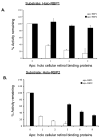In vitro and in vivo characterization of retinoid synthesis from beta-carotene
- PMID: 18295589
- PMCID: PMC2587144
- DOI: 10.1016/j.abb.2008.02.010
In vitro and in vivo characterization of retinoid synthesis from beta-carotene
Abstract
Retinoids are indispensable for the health of mammals, which cannot synthesize retinoids de novo. Retinoids are derived from dietary provitamin A carotenoids, like beta-carotene, through the actions of beta-carotene-15,15'-monooxygenase (BCMO1). As the substrates for retinoid-metabolizing enzymes are water insoluble, they must be transported intracellularly bound to cellular retinol-binding proteins. Our studies suggest that cellular retinol-binding protein, type I (RBP1) acts as an intracellular sensor of retinoid status that, when present as apo-RBP1, stimulates BCMO1 activity and the conversion of carotenoids to retinoids. Cellular retinol-binding protein, type II (RBP2), which is 56% identical to RBP1 does not influence BCMO1 activity. Studies of mice lacking BCMO1 demonstrate that BCMO1 is responsible for metabolically limiting the amount of intact beta-carotene that can be absorbed by mice from their diet. Our studies provide new insights into the regulation of BCMO1 activity and the physiological role of BCMO1 in living organisms.
Figures








Similar articles
-
Beta,beta-carotene decreases peroxisome proliferator receptor gamma activity and reduces lipid storage capacity of adipocytes in a beta,beta-carotene oxygenase 1-dependent manner.J Biol Chem. 2010 Sep 3;285(36):27891-9. doi: 10.1074/jbc.M110.132571. Epub 2010 Jun 23. J Biol Chem. 2010. PMID: 20573961 Free PMC article.
-
Hepatic stellate cells are an important cellular site for β-carotene conversion to retinoid.Arch Biochem Biophys. 2010 Dec 1;504(1):3-10. doi: 10.1016/j.abb.2010.05.010. Epub 2010 May 12. Arch Biochem Biophys. 2010. PMID: 20470748 Free PMC article.
-
Expression of genes associated with retinoid metabolism in the trout ovarian follicle.Biol Reprod. 2008 Sep;79(3):570-7. doi: 10.1095/biolreprod.107.066548. Epub 2008 May 7. Biol Reprod. 2008. PMID: 18463359
-
Importance of β,β-carotene 15,15'-monooxygenase 1 (BCMO1) and β,β-carotene 9',10'-dioxygenase 2 (BCDO2) in nutrition and health.Mol Nutr Food Res. 2012 Feb;56(2):241-50. doi: 10.1002/mnfr.201100387. Epub 2011 Dec 7. Mol Nutr Food Res. 2012. PMID: 22147584 Review.
-
Carotenoids, β-Apocarotenoids, and Retinoids: The Long and the Short of It.Nutrients. 2022 Mar 28;14(7):1411. doi: 10.3390/nu14071411. Nutrients. 2022. PMID: 35406024 Free PMC article. Review.
Cited by
-
Rare genetic variation at Zea mays crtRB1 increases beta-carotene in maize grain.Nat Genet. 2010 Apr;42(4):322-7. doi: 10.1038/ng.551. Epub 2010 Mar 21. Nat Genet. 2010. PMID: 20305664
-
Importance of ALDH1A enzymes in determining human testicular retinoic acid concentrations.J Lipid Res. 2015 Feb;56(2):342-57. doi: 10.1194/jlr.M054718. Epub 2014 Dec 11. J Lipid Res. 2015. PMID: 25502770 Free PMC article.
-
The biochemical and structural basis for trans-to-cis isomerization of retinoids in the chemistry of vision.Trends Biochem Sci. 2010 Jul;35(7):400-10. doi: 10.1016/j.tibs.2010.01.005. Epub 2010 Feb 24. Trends Biochem Sci. 2010. PMID: 20188572 Free PMC article. Review.
-
Lycopene biodistribution is altered in 15,15'-carotenoid monooxygenase knockout mice.J Nutr. 2008 Dec;138(12):2367-71. doi: 10.3945/jn.108.099663. J Nutr. 2008. PMID: 19022959 Free PMC article.
-
Cardiac dysfunction in β-carotene-15,15'-dioxygenase-deficient mice is associated with altered retinoid and lipid metabolism.Am J Physiol Heart Circ Physiol. 2014 Dec 1;307(11):H1675-84. doi: 10.1152/ajpheart.00548.2014. Epub 2014 Sep 26. Am J Physiol Heart Circ Physiol. 2014. PMID: 25260612 Free PMC article.
References
-
- Sporn MB, Roberts AB, Goodman DS. The Retinoids : Biology, Chemistry, and Medicine. 2. Raven Press; New York: 1994.
-
- Chambon P. A decade of molecular biology of retinoic acid receptors. Faseb J. 1996;10:940–954. - PubMed
-
- Evans RM. The nuclear receptor superfamily: a rosetta stone for physiology. Mol Endocrinol. 2005;19:1429–1438. - PubMed
-
- Pennimpede T, Cameron D, Petkovich M. Regulation of murine embryonic patterning and morphogenesis by retinoic acid signaling. Adv Dev Biol. 2006;16:65–104.
-
- Balmer JE, Blomhoff R. Gene expression regulation by retinoic acid. J Lipid Res. 2002;43:1773–1808. - PubMed
Publication types
MeSH terms
Substances
Grants and funding
LinkOut - more resources
Full Text Sources
Other Literature Sources
Molecular Biology Databases
Research Materials

